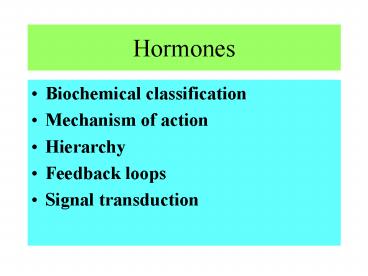Hormones - PowerPoint PPT Presentation
1 / 22
Title: Hormones
1
Hormones
- Biochemical classification
- Mechanism of action
- Hierarchy
- Feedback loops
- Signal transduction
2
Polypeptides
Oxytocin thyrotropin ACTH
Insulin glucagon somatotropin
FSH LH vasopressin
Steroids
Aldosterone corticosterone Progesterone
Estrogen testosterone cortisol
Amino acid derivatives
Epinephrine norepinephrine dopamine
Thyroxine, T3 and T4 Melatonin Serotonin
3
Rule All hormones interact with target cells by
first binding to specific receptors located
either on the plasma membrane or as a cytosolic
protein
Rule The receptor for hormones must be
linked to a component that is able to respond to
the binding of hormone with its receptor
Rule Substances that fool the responder
into thinking a hormone has bound are call
agonists
Rule Substances that prevent the binding of
the natural hormone and do not elicit a response
from the receptor are called antagonists
4
Nitric oxide
T-cell Activation
Glucagon
Insulin
1
3
4
5
2
IP3
G
G
G
G
Tyrosine kinase
G protein
Protein substrates
Cyclic GMP
Ca2
Diacylgycerol
Cyclic AMP
Calmodulin
PK-C
PK-A
PK-G
Protein Ser/Thr kinases
Protein substrates
Protein substrates
Multifunctional kinases
End result is phosphorylation of one or more
proteins
Other phospholipases
Protein substrates
5
Hypothalamus
Nervous
Releasing hormones
Anterior pituitary
Posterior pituitary
Thyrotropin
Somatotropin
FSH
Vasopressin
Prolactin
LH
Oxytocin
ACTH
Adrenal Cortex
Adrenal Medulla
Thyroid
Pancreas
Ovary
Testis
Estradiol
Insulin, glucagon, somatostatin
Cortisol aldosterone
Testosterone
T3
Epinephrine
Reproductive organs
Muscles liver
Liver, muscles
Mammary glands
Tissues
6
Feedback Loops
Rule Hormones elicit their own shut off mechanism
Hypothalamus
Anterior Pituitary
Corticotropin releasing factor
Adrenal Cortex
?-Corticotropin
Cortisol
7
Rule All peptide hormones are synthesized
as inactive pre-pro precursors
Rule A signal peptide must be cleaved off to
activate the mature form of the hormone
8
Signal Transduction
Definition The series events and components
that take part in transmitting a hormonal signal
to a the interior of the cell
Membrane or cytosolic Receptor
Signal Initiator
Signal mediator
Target molecule
9
Cyclic AMP System
Receptor
G-protein
Stimulate (Gs) and inhibit (Gi)
Adenylate cyclase
c-AMP
Protein kinases
10
G-Proteins
A family of membrane proteins that exist in an
inactive (GDP) and an active (GTP) state
So-named because they bind GTP, displacing GDP
Work with many receptors
Both Stimulate and inhibit hormone signals
GTP is a time-bomb slowly ticking
When GTP is hydrolyzed to GDP, stimulation is
stopped
11
Resting
ATP
Active
cAMP
Inactive
PO4
Resting
12
hormone
Inhibitor
Ri
RS
AC
?
GDP ?
GTP ?
?
GDP
4 ATP
GTP
AT
Inactive protein
Protein kinase
4 cAMP
Adenylate cyclase Signaling System
Active protein
Cell response
13
Ligand
N
Cross phosphorylation
C
Tyrosine Kinase Receptors
14
Extracellular
Growth hormone
Extracellular domain of Growth Hormone
Receptor
Binding to receptor forces dimerization of
receptor subunits for cross phosphorylation
O3PO-
-OPO3
Tyrosines
Cell membrane (lipid bilayer)
Intracellular
Growth Hormone Receptor
15
Cell Signaling via RTK and Ras
Kinases
16
Challenge to Students
- Many of the proteins that you just saw are coded
by genes referred to as oncogenes, meaning they
are capable of transforming a normal cell into a
cancer cell. Src, Ras, ErbB, affect cell growth
and differentiation. - The viral forms of these genes lack regulation,
and the mammalian form (proto-oncogenes) are
subject to mutation. - If you want to learn what causes a normal cell to
become a cancer cell (malignant transformation),
this is a good place to start.
17
What is Behind the Biochemistry of Cancer?
- An alteration of genes/proteins involved in
a. Cell proliferation
b. Apoptosis (programmed cell death)
c. Differentiation
2. Acquisition of a phenotype that allows cells
to
a. Proliferate without limits
b. Evade apoptosis
c. Generate its own mitogenic signals
d. Ignore growth inhibitory signals
e. Acquire vasculature (angiogenesis) solid
tumors
f. Invade and colonize (metastasize) other tissue
18
Genes Mutated 1. ras protein (25 of cancers)
2. p53 tumor suppressor (50 of cancers)
a. controls DNA repair
b. controls apoptosis
3. Tyrosine kinase receptor (HER2/neu)
a. controls ras (overexpression)
19
We Know
1. Biochemical pathways from ras to p53
2. Role of p53 in apoptosis and DNA repair
We Dont Know
1. Molecular circuitry for enhancing secretion of
angiogenic factors from cancer cells
2. The regulation of elements controlling the
migration and extravastion capabilities of cancer
cells
20
Take Home
- Most hormones never penetrate cells
- All hormones have receptors
- Internal responses are initiated by the receptor
- Receptors work with G proteins
- G proteins stimulate protein kinases
- Protein kinases comprise a cell signaling cascade
- G proteins turn off when GTP is hydrolyzed to
GDP, canceling the hormone action
21
Take Home (Part 2)
- Some receptors are protein tyrosine kinases
- Kinase activity is initiated by dimerization
- Kinase autophosphorylate receptors
- Phosphotyrosines bind to SH-2 domains
- Activation starts a kinase cascade
- Phosphorylated proteins enter nucleus
- DNA transcription turns on specific genes
22
Final Exam
- Monday, May 10
- 1030 a.m. 1230 p.m.

